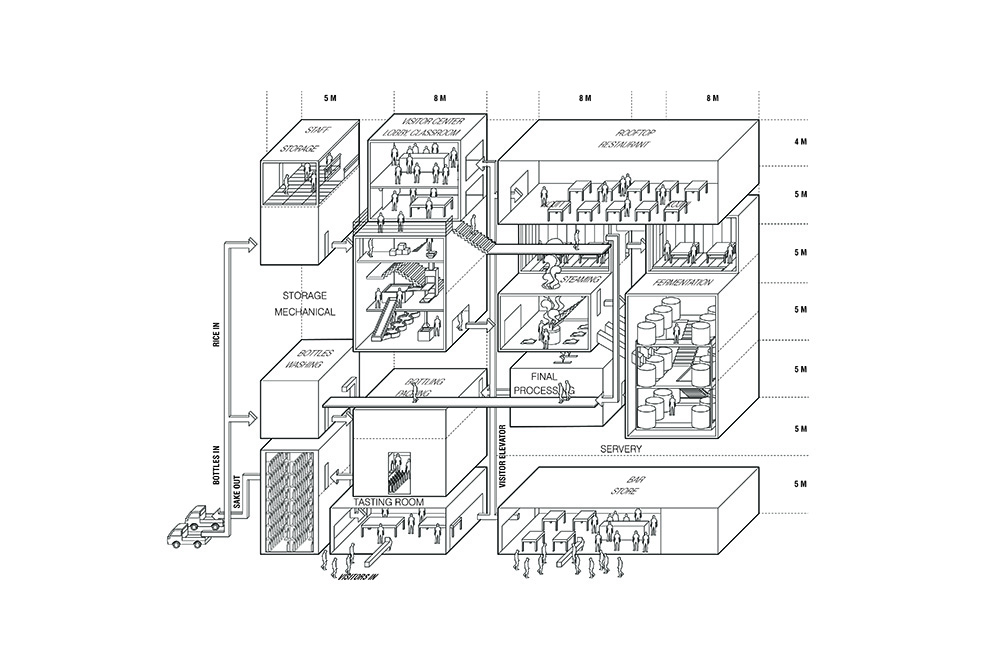
This is the fourth column of “Practice Values,” a bi-monthly series by architect and technologist Phil Bernstein. The column focuses on the evolving role of the architect at the intersection of design and construction, including subjects such as alternative delivery systems and value generation. Bernstein was formerly vice president at Autodesk and now teaches at the Yale School of Architecture.
I recently sat on a midterm design jury for the Yale studio taught by the dynamic duo of Patrick Bellew of Atelier Ten and Andy Bow of Foster + Partners. It’s a rare treat for those of us who teach in the “suburbs” of the curriculum (in my case, professional practice) to visit the hip “downtown nightclub” scene of the design studios. The jury comprised far more talented designers than me, so I kept my focus and comments on issues of process and outcomes.
The brief was both thrilling and daunting: Design a museum and restaurant complex, including production facilities, for a sake company in historic Kyoto, Japan, on one of two challenging sites facing a shallow river; acknowledge the intricate urban context; solve for the production complexities of the ancient art of sake manufacturing; create a strong work of architecture. And, by the way, make your solution environmentally responsible through clear sustainable design strategies. The morning sake tasting we held before the jury began steeled both the jurors and the students for the intense day ahead.

As I watched our students present their projects, I was amazed at their energy, determination, and facility with almost every challenge of the brief. It was midterm, so many issues were not unexpectedly left unresolved, but few were ignored. Andy and Patrick had guided these 10 folks to unique, provocative, and dare I say even poetic solutions. It was hard for this architect, trained in these same jury pits in the pre-digital age, to believe the sheer skill with which these schemes were iterated, analyzed, evaluated, and presented. There was no question that the students’ development as designers was accelerated by an ability to deploy digital tools—visualization, cogent drawing and diagramming, CNC-model fabrication—in the service of their craft augmented with an array of beautiful hand sketches. All these skills were clearly mutually amplifying. I don’t think any of my final presentations in school were nearly as resolved, nor presented so beautifully.
The jury and students met after the review to discuss more general observations, when I explained that the biggest surprise of the day for me, to wit, was the generally tangential treatment that sustainability received in the solutions. There were the typical gestures to ventilation, the movement of the sun, or attempts to co-locate hot and cold functions in the sake factory, but overall the sustainability challenge received much the same treatment that might have been given if the brief had had a building code requirement—it was considered somehow adjacent to the central problems of the Design with a big “D.” I was reminded of a statement made by one of my professors, Vincent Scully, when I asked him about the importance of “solar architecture,” a design approach popular in the 1970s: “Oh, that’s just plumbing.”
Somehow the digital facility applied to solving the context, planning, massing, and compositional challenges of the brief was nowhere apparent in answering questions of sustainability. A wide array of computational analytical tools is easily available to today’s students, ranging from various Rhino-based Grasshopper scripts, through Energy Plus, to Impact Infrastructure’s AutoCASE. It may be that Patrick and Andy will press this particular part of the pedagogical agenda later in the term. If so, our students would benefit from the advice of juror Michelle Addington, Hines Professor of Sustainable Architectural Design at Yale University School of Architecture, who suggested that the tyranny of the sustainable checklist (such as LEED or BREAM) should lead to choosing a single important green strategy, and making sure that it’s accomplished well. The tools are certainly there to do so.
This seems a reasonable teaching strategy if combined with another requirement: demonstrable outcomes of that given green approach. Today’s digital design tools provide vivid answers to design questions of composition, drawing clarity, senses of three-dimensional space. Analytical algorithms that evaluate the quantitative results of a scheme are the “renderings” of sustainability, with hard and fast results. While those results may be only approximations as a design evolves, they are also a measure of sustainable success or failure. And learning to deliver those results in concert with
a skillful design prepares these same students to make the demonstrable value arguments that future practice will demand. This will be a central theme of some of my subsequent columns.
